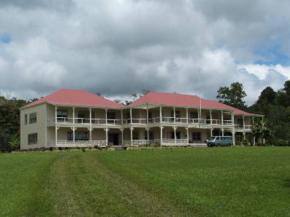Stevenson’s fabulous Pacific Home

The thickly wooded avenue that yaws off the main road and leads up to the foot of Mount Vaea doesn’t quite prepare you for the breathtaking agora at the end of the short drive. Placed in the middle of this large open space with an impeccably manicured lawn is a mansion that has come to become one of the most important of historical buildings in the South Pacific: Author Robert Louis Stevenson’s Samoan home, Vailima.
Just a four-and-a-half kilometre drive from the bustle of the Samoan capital of Apia, Vailima stands majestic on an elevated plateau, commanding a beautiful view of the Pacific Ocean from over the treetops. It is easy to see that the mansion’s sweeping verandahs overlooking much of the estate were a perfect setting for Stevenson’s story-telling genius as he wrote his famous tales Ebb Tide, The Beach At Falesa, The Bottle Imp, and David Balfour among others.
Stevenson came to Samoa in 1893 at the end of a long search for a climate that would help against his chronic tubercular condition. Accompanied by his wife Fanny and an assorted entourage consisting of fanny’s children by a previous marriage and other relatives, the writer settled at Vailima and lived there for four years until his death.
In his letters to friends, he describes how the family with the help of locals cleared the site and constructed the house. He also writes the place is called Vailima after a legend which speaks of a confluence of five streams close by. There is no sign of those streams today, but the legend endures –and the museum guides tell it with great relish.
After his death and the departure of his family, the building was used by the Germans and later as a state house. Parts of the building (like the wing on the left as you face it) have been built much later. The entire structure itself has been restored in the 1990s before it was turned into a museum and a place that Samoa is truly proud of.
The handsome house has been restored with great care. The furniture, books, personal and household effects have all been well tended and are guaranteed to transport you to a world before jet planes, televisions and cars. There are book cases full of Stevenson’s personal collection of tomes, a few first editions of his great works –some of them signed by him; crates and bags used by the family as they travelled across the Atlantic, mainland United States and then the Pacific, as their masters looked for a climatic utopia, until they arrived at their final resting place here in Vailima.
Fanny’s four-poster bed as well as other beds in the many bedrooms are remarkably well restored and reflect the style in which the well-endowed family lived out their brief sojourn at Vailima (Stevenson and the considerably older Fanny, though, had separate bedrooms at Vailima). The family medicine chest with a sizable collection of antique bottles and ampoules in an adjoining room, however, stand mute testimony to the long-suffering writer’s troubled last days.
Fanny’s treadle sewing machine with a heavy pair of tailor’s scissors placed on its deck stands wistfully by one of the large windows overlooking the extended back yard. The family’s collection of paintings and sepia-toned photographs peer curiously at visitors along corridors and the well-polished flight of stairs leading to the upper floor. It is easy to spot the writer and his wife –and the guide helps identify the rest.
The mansion’s architecture is decidedly colonial from the outside but the interiors are a mixed fare of the west and the Pacific. For instance, Masi (decorated bark) covers the walls of many a room replacing wallpaper. The fireplace in one of the lounges on the lower floor is clearly out of place in this sweltering tropical weather. “It was never ever used,” says the museum guide. “One doesn’t know why it was ever built.” A cheetah skin adorns a corner of the room and is also obviously an import that found its way into the writer’s huge collection of bric-a-brac. In a second lounge on the lower floor stands a life-sized statue of the frail-framed writer. The floor of this lounge is covered with fine Masi and in a corner stands a splendid piano.
Stevenson clearly struck a rapport with locals and interacted with them closely. He spent a great deal of time with them and acquainted himself with their culture and social mores. In some of his later writings, he sought to set right much of the misrepresentation of Pacific peoples by earlier writers. Samoans grew to adore him and endearingly named him “Tusitala”, which means storyteller. Both Tusitala and Vailima –the latter better known as Samoa’s fine beer– are enduring names in Samoa today.
One of the rooms has been converted into an office and bookshop that also sells souvenirs. Picking up your favourite title by Stevenson at his last home is like taking a part of Vailima’s rich memory back with you. My choice was Jekyll and Hyde!
The thickly wooded avenue that yaws off the main road and leads up to the foot of Mount Vaea doesn’t quite prepare you for the breathtaking agora at the end of the short drive. Placed in the middle of this large open space with an impeccably manicured lawn is a mansion that has come to become one...
The thickly wooded avenue that yaws off the main road and leads up to the foot of Mount Vaea doesn’t quite prepare you for the breathtaking agora at the end of the short drive. Placed in the middle of this large open space with an impeccably manicured lawn is a mansion that has come to become one of the most important of historical buildings in the South Pacific: Author Robert Louis Stevenson’s Samoan home, Vailima.
Just a four-and-a-half kilometre drive from the bustle of the Samoan capital of Apia, Vailima stands majestic on an elevated plateau, commanding a beautiful view of the Pacific Ocean from over the treetops. It is easy to see that the mansion’s sweeping verandahs overlooking much of the estate were a perfect setting for Stevenson’s story-telling genius as he wrote his famous tales Ebb Tide, The Beach At Falesa, The Bottle Imp, and David Balfour among others.
Stevenson came to Samoa in 1893 at the end of a long search for a climate that would help against his chronic tubercular condition. Accompanied by his wife Fanny and an assorted entourage consisting of fanny’s children by a previous marriage and other relatives, the writer settled at Vailima and lived there for four years until his death.
In his letters to friends, he describes how the family with the help of locals cleared the site and constructed the house. He also writes the place is called Vailima after a legend which speaks of a confluence of five streams close by. There is no sign of those streams today, but the legend endures –and the museum guides tell it with great relish.
After his death and the departure of his family, the building was used by the Germans and later as a state house. Parts of the building (like the wing on the left as you face it) have been built much later. The entire structure itself has been restored in the 1990s before it was turned into a museum and a place that Samoa is truly proud of.
The handsome house has been restored with great care. The furniture, books, personal and household effects have all been well tended and are guaranteed to transport you to a world before jet planes, televisions and cars. There are book cases full of Stevenson’s personal collection of tomes, a few first editions of his great works –some of them signed by him; crates and bags used by the family as they travelled across the Atlantic, mainland United States and then the Pacific, as their masters looked for a climatic utopia, until they arrived at their final resting place here in Vailima.
Fanny’s four-poster bed as well as other beds in the many bedrooms are remarkably well restored and reflect the style in which the well-endowed family lived out their brief sojourn at Vailima (Stevenson and the considerably older Fanny, though, had separate bedrooms at Vailima). The family medicine chest with a sizable collection of antique bottles and ampoules in an adjoining room, however, stand mute testimony to the long-suffering writer’s troubled last days.
Fanny’s treadle sewing machine with a heavy pair of tailor’s scissors placed on its deck stands wistfully by one of the large windows overlooking the extended back yard. The family’s collection of paintings and sepia-toned photographs peer curiously at visitors along corridors and the well-polished flight of stairs leading to the upper floor. It is easy to spot the writer and his wife –and the guide helps identify the rest.
The mansion’s architecture is decidedly colonial from the outside but the interiors are a mixed fare of the west and the Pacific. For instance, Masi (decorated bark) covers the walls of many a room replacing wallpaper. The fireplace in one of the lounges on the lower floor is clearly out of place in this sweltering tropical weather. “It was never ever used,” says the museum guide. “One doesn’t know why it was ever built.” A cheetah skin adorns a corner of the room and is also obviously an import that found its way into the writer’s huge collection of bric-a-brac. In a second lounge on the lower floor stands a life-sized statue of the frail-framed writer. The floor of this lounge is covered with fine Masi and in a corner stands a splendid piano.
Stevenson clearly struck a rapport with locals and interacted with them closely. He spent a great deal of time with them and acquainted himself with their culture and social mores. In some of his later writings, he sought to set right much of the misrepresentation of Pacific peoples by earlier writers. Samoans grew to adore him and endearingly named him “Tusitala”, which means storyteller. Both Tusitala and Vailima –the latter better known as Samoa’s fine beer– are enduring names in Samoa today.
One of the rooms has been converted into an office and bookshop that also sells souvenirs. Picking up your favourite title by Stevenson at his last home is like taking a part of Vailima’s rich memory back with you. My choice was Jekyll and Hyde!









Leave a Comment